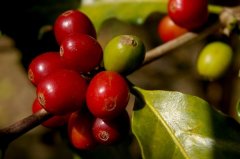Coffee roasting: the roasting degree of coffee beans varies according to how to drink roasted coffee beans.
For professional baristas, please follow the coffee workshop (Wechat official account cafe_style)
Coffee roasting Coffee roasting machine
Dark roasted coffee beans light roasted coffee beans
Dark and light roasted coffee beans
Roasted coffee transforms the chemical and physical properties of raw coffee beans into roasted coffee products. The roasting process causes raw beans to expand and change their color, taste, smell and density, resulting in the special flavor of coffee. Unroasted coffee beans and roasted coffee beans contain similar acidity, protein and caffeine, but lack their good taste. The process needs to be hot enough to accelerate Maillard's reaction with other chemical reactions that add flavor.
As raw coffee beans are much more stable than roasted coffee beans, the roasting process tends to take place near the consumer market. This reduces the delivery time of roasted coffee beans and maximizes the shelf life of coffee beans. The vast majority of coffee beans are roasted commercially on a large scale, but some coffee drinkers bake their own beans in order to accurately control their freshness and taste.
Baking
These images describe the name and description of the subjective roasting of the same batch of sample beans at different temperatures. [1]
Unbaked
22 °C (72 °F) new bean
Green coffee, They can be stored for approximately 12-18 months in a climate controlled environment before quality loss is noticeable.
165 °C (329 °F) drying stage
During the drying phase the beans are undergoing an endothermic process until their moisture content is evaporated, signifying first crack.
Light baking
196C (385F) Cinnamon Roast
A very light roast level which is immediately at first crack. Sweetness is underdeveloped, with prominent toasted grain, grassy flavors, and sharp acidity prominent.
205 °C (401 °F) extremely shallow baking, also known as "shallow baking"
The surface is light cinnamon, with a strong grassy taste, lack of taste and aroma, and sharp acidity.
Medium baking
210C (410F) American Roast
Medium light brown, developed during first crack. Acidity is slightly muted, but origin character is still preserved.
Deep baking in 219 °C (426 °F), also known as "urban baking"
The surface is light brown, the taste is bright and lively, the acidity between sour and bitter balance is light, and release the high-quality flavor of coffee, which is the standard baking degree.
Heavy baking
225 °C (437 °F) micro-depth baking, namely deep baking, also known as "deep city baking"
The surface is brown, for the Central and South American baking method, more iced coffee, black coffee use, the beginning of the second explosion.
230C (446F) Vienna Roast
Moderate dark brown with light surface oil, more bittersweet, caramel flavor, acidity muted. In the middle of second crack. Any origin characteristics have become eclipsed by roast at this level.
240 °C (464 °F) very deep baking, namely deep baking, also known as "French baking"
The surface is dark brown with black, strong taste, bitter taste, glossy oil, burning meaning, acidity weakening, with strong chocolate and smoky aroma, the end of the second burst. [2]
245 °C (473 °F) extremely deep baking, also known as "semantic baking"
The surface is nearly black and glossy, the taste is strong and complex, bitter, with a strong fried and scorched aroma, acidity is almost eliminated, mostly used for Italian coffee Espresso. [3]
Gallery
Several stages of unbaked coffee beans: (left to right) air-dried for a year, air-dried, fresh.
Light color baked samples, compared with dark roasted coffee beans. The ideal baking temperature is usually very subjective and changeable.
An old high-capacity coffee roaster made of cast iron.
Mengshao, a coffee roaster in the window (Germany)
Important Notice :
前街咖啡 FrontStreet Coffee has moved to new addredd:
FrontStreet Coffee Address: 315,Donghua East Road,GuangZhou
Tel:020 38364473
- Prev

Characteristics of Coffee planting in Xidamo Coffee producing area what are the characteristics of coffee plantation in Guji producing area?
Professional barista exchange please follow the coffee workshop (Wechat official account cafe_style) Ethiopia washed Sidamo G1 Valley Jikol Shamakanisha Nisha processing plant LOT#2 (Ethiopia Washed Sidama Guji Kercha Mokonisa Mill Lot#2) flavor description: apricot peach, lemon, sweetened peach, tender ginger, floral notes, juicy and rich taste, sweet sugar, citrus
- Next
Comparison table of roasting degree of coffee beans how to bake coffee beans at home and judge the roasting degree of coffee beans
Professional barista communication please follow the coffee workshop (Wechat official account cafe_style) 1. When studying the roasting degree of coffee beans, the degree of roasting can be judged by sound, color and aroma. Its color ranges from light gray to dark brown, its aroma is from light and elegant, and the sound is made two times. Take the heat-resistant raw bean as an example, the first explosion begins at about 7 points and lasts for about 2 minutes.
Related
- Beginners will see the "Coffee pull flower" guide!
- What is the difference between ice blog purified milk and ordinary milk coffee?
- Why is the Philippines the largest producer of crops in Liberia?
- For coffee extraction, should the fine powder be retained?
- How does extracted espresso fill pressed powder? How much strength does it take to press the powder?
- How to make jasmine cold extract coffee? Is the jasmine + latte good?
- Will this little toy really make the coffee taste better? How does Lily Drip affect coffee extraction?
- Will the action of slapping the filter cup also affect coffee extraction?
- What's the difference between powder-to-water ratio and powder-to-liquid ratio?
- What is the Ethiopian local species? What does it have to do with Heirloom native species?

